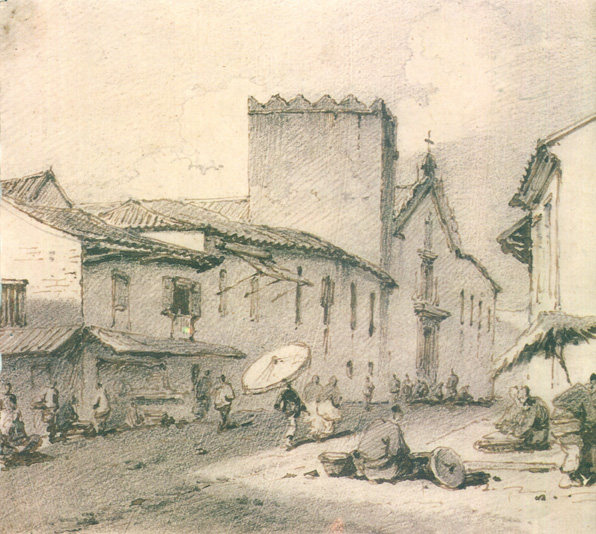 Macau's charitable institution, the Santa Casa da Misericórdia by George Chinnery (ink and pencil on paper, no date, 14.7 X 17.6 cm, Luís de Camões Museum) The sketch portrays an intimate picture of city life and is one of the most beautiful, subtle images of Macau in the XIXth century to come from George Chinnery.
Macau's charitable institution, the Santa Casa da Misericórdia by George Chinnery (ink and pencil on paper, no date, 14.7 X 17.6 cm, Luís de Camões Museum) The sketch portrays an intimate picture of city life and is one of the most beautiful, subtle images of Macau in the XIXth century to come from George Chinnery.
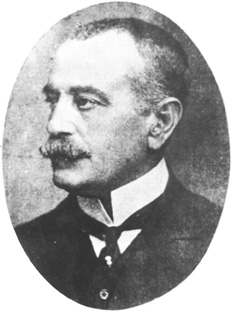
The Count of Arnoso arrived in Macau on the 23rd of June, 1887, together with Tomás de Sousa Roque who was going to Peking for the signing of the first Sino-Portuguese Treaty. In his book Jornadas pelo Mundo, p. 113, he tells us the following: 'Aboard the gunboat Rio Lima, we left Hong Kong at eight o'clock on the morning of the 23rd of June, for Macau. As we were sailing against both the wind and tide it took us five hours to complete the forty-mile long trip. At around one o'clock we entered the bay opposite the Praia Grande. We watched those waters with respect and pride because an ancestor of ours, Jorge Pinheiro de Lacerda, was buried there during the restoration period, fighting against the Dutch. Outnumbered by the enemy, as the chronicler says, he killed him self by setting the ship's hold on fire after removing all previously hoisted signs of victory from the masts. Two centuries later, we who have the same blood running in our veins and have the same family name, feel proud to call at the same port aboard a Portuguese Army ship manned by a crew who would rather die than surrender in similar circumstances.'
This is a good story, or perhaps more appropriately we might call it a 'yarn', since no historical trace has so far been found of Jorge de Lacerda. It would be interesting to know how this story originated.
FORESTATION OF MACAU
Governor Tomás de Sousa Rosa (1883-1886) was responsible for the forestation of Macau and its green areas. He took great interest in this project, personally supervising and working on the scheme. Engineer Adolfo Loureiro in his book No Orientede Nápoles à China refers to this aspect when he reports the visit that he and Governor Rosa paid to the Flora nursery in 1883: 'We examined the vivarium and seed fields, which forced my good friend Rosa to hold the spade to teach the Chinese, like any simple man in Lisbon can do, how to take care of plants. The forestation of those slopes is going well and the Governor's care for this big improvement is in fact a great service. Those white slopes cut by rain, arid and dry, will look wonderful when they are finally covered with plants!...'
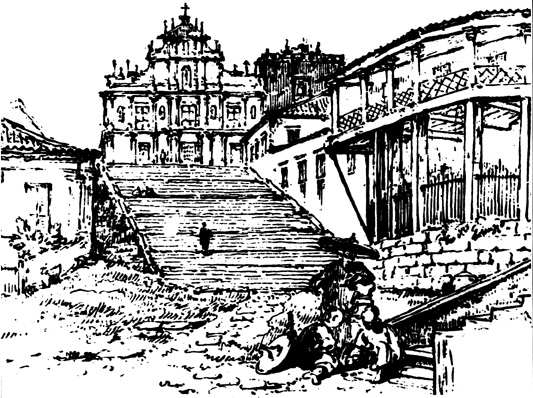 St. Paul's Church, by G. Chinnery (drawing - Luís de Camões Museum Collection). This drawing was done prior to 26th January, 1835 as this was the day the college's kitchens were set ablaze (around 6.00pm). At 8.00pm the fire had destroyed the large clock given by Luís XIV.
St. Paul's Church, by G. Chinnery (drawing - Luís de Camões Museum Collection). This drawing was done prior to 26th January, 1835 as this was the day the college's kitchens were set ablaze (around 6.00pm). At 8.00pm the fire had destroyed the large clock given by Luís XIV.
The Count of Arnoso came to Macau in 1887 with Tomás Rosa, and wrote the following in his book Jornadas pelo Mundo, p. 116: 'The peninsula of Macau is small and surrounded by islets. It features a fertile lea and six gracious hills - Guia, Penha de França, Mong-Ha, D. Maria and Camões Grotto, making it extremely picturesque. When the sixty thousand trees, planted by order of Tomás Rosa, cover those hills with their shade, Macau will become the most popular resort in the Far East in summer. Even now Hong Kong people seek shelter in Macau from the hot season.'
It is to be hoped that the work of Tomás Rosa is not destroyed by progress.
GOVERNMENT HOUSE
The Count of Arnoso gives the following account of Government House: 'The Government House was bought from the Cercal family and is a beautiful building. It housed some government departments for some time. Later, during the former administration, they were all transferred to the previous Government House which is also a very fine building, with its court hall, the former royal hall. Many district capitals in Portugal would not mind having this building for their departments, and we all wish the Boa-Hora Court could look a little like the Macau Court!'
In fact, the present Government House in the middle of Praia Grande, was rented on 8th June 1873 by the Viscount of Cercal, Alexandrino António de Melo, to Governor José Maria Lobo d'Ávila.
The Viscount passed away and his widow, Lady Carlota Botelho de Melo, sold it to the Government for $25,068.66 upon approval by the Lisbon government, dated 17th May 1881. At the time, the Governor of Macau was Joaquim José da Graça (1879-1883).
The Judicial Department and the Public Finances Department were located in the new Government House for some time.
Tomás da Sousa Rosa (1883-1886) moved all departments to the old Government House, which was located opposite the Jorge Álvares statue. Therefore, the above-mentioned building housed the following departments: Chinese Affairs, Public Finances and Court with relevant notaries and Tax Services. The Court Hall was majestic, but the other rooms which were occupied by notaries, were wet and dark. This building was pulled down and later, in 1951, the present government departments building was built in the same place.
ST. FRANCISCO
'The construction of the S. Francisco barracks at the far end of Praia Grande, was ordered by Governor Coelho do Amaral. It is a large and ventilated construction, in good condition, and houses the Overseas Regiment in Macau. Above it, on top of a small hill, lies the magnificent and elegant S. Januário Hospital which was built thanks to the Count of S. Januário,' reports the Count of Arnoso.
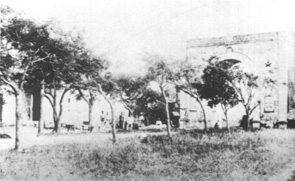

The report presented above is correct. Upon a government decision dated the 30th March 1861, the S. Francisco convent was pulled down and the barracks for the First Line Battalion was built. The plan was designed by Governor José Rodrigues Coelho do Amaral himself and he also directed the construction works. On the 30th of December 1866 the Battalion moved in and built a fortress where the old fortress was, next to the barracks.
As regards the Military Hospital, it was built by the Viscount who later became the Count of S. Januário. The work started on the 1st of December 1872 and took one year to complete. The opening ceremony took place on the 6th of January 1874. It was named S. Januário Military Hospital, after the patron saint of the Governor. Later, some devious minds changed its name to Count of S. Januário Hospital.
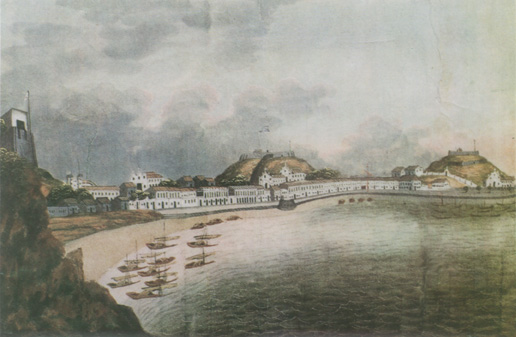 Praia Grande View (1834) - by Tingqua
(Gouache on 18 x 28 cm paper. Luís de Camões Museum Collection).
Praia Grande View (1834) - by Tingqua
(Gouache on 18 x 28 cm paper. Luís de Camões Museum Collection).
THE POST OFFICE
After describing the Government Palace, the Count of Arnoso gives us an account of a small building next to it which housed the Post Office: 'Next to it is the small Post Office building, which was also inaugurated during Thomaz Rosa's office. Prior to that there was no Post Office in the province. Mail used to be sent to Hong Kong's Post Office by boat.'
Well, this is not quite true, because Macau's Post Office was operating forty years prior to the foundation of Hong Kong.
The Post Office in Macau was founded by the 'Leal Senado' (City Council) on the 11th of June 1800 upon a decision taken by the Goa Council on the 22nd of May of the previous year, of which the Governor of India, Francisco António da Veiga Cabral, advised his Macau counterpart. It was stated that mail should be subject to charges and the administrator's pay was also specified. The oldest administrator known to date is Felix Vicente Coimbra, whose name is in a document dated the 1st of January 1822. Later, on the 15th of January 1824, it was established that that department would be under the City Council's responsibility. This so-called pre-sticking period lasted from 1800 to 1884. Tomás Rosa, in his Decision no.11 dated the 27th of February 1884, ordered that the first sticking stamps should be circulated from the 1st of March 1884.
ST. LÁZARO CHURCH
On pages 118-19, the Count of Arnoso writes that: 'St. Lázaro's, located in a Chinese Christian district, is the oldest church in Macau. This is the reason why all newly-appointed bishops take the oath in this church and not in the See. The Chinese living in this district are the best in Macau; those who emigrate, and most of them do as soon as they have saved money, return, buy a house close to their church, or a piece of land on which to build. They resemble those families of hard-working and happy immigrants from the north of Portugal. This old landmark of our faith was collapsing and was saved by Thomaz Rosa's government. St. Lázaro's church was rebuilt and is the most beautiful of all.'
St. Lázaro's Christians were very grateful to Tomás Rosa because he pulled down their old church and built a new one. He also treated the Chinese community well. In recognition of it, in August 1886, they gave him a silver work of art, a silk ribbon and a painting displaying a Chinese dedication.
The Count of Arnoso's account is true. Until 1976, the new bishop would go on procession to the See via St. Lázaro's. For many centuries it was believed that St. Lázaro's was the oldest church. After 20 years of research I came to the conclusion that such belief is groundless because of the reasons below: -
(1) No XVIth century document refers to this church;
(2) St. Lázaro's population was all Chinese, not a single Portuguese lived there;
(3) St. Lázaro's small church was used by lepers who lived isolated from everybody else;
(4) The first Christians settled there only in 1808;
(5) There is no account of any vicar nor baptism in that church prior to XIXth century;
(6) The Chinese church was not St. Lázaro's but Our Lady of Amparo's instead.
The above reasoning leads me to believe that in fact the Church of Our Lady of Hope (best known as St. Lázaro's) was not the first in Macau.
ST. PAUL'S RUINS
According to the Count of Arnoso, '... St. Paul's Ruins, where the Jesuits ran the largest college in the East, was for a while used as barracks and later destroyed by fire.
Currently, around the ruins where in former times the Company's priests used to stroll, Chinese and pigs live in filthy conditions!'
Arnoso was in Macau in 1887. In 1905, Dr. António José Gomes, in his sermon preached at St. Paul's Ruins, said that: 'Three months ago this place was filthy! Three months ago, this sacred place, on the inside of the ruins of the most beautiful temple in Macau, which was designed three centuries ago by an apostle and a martyr, was full of dirty animals and served as latrine for runaways who live around the ruins in places dirtier than dens. A precious relic of Christian art has been insulted. They have tried to steal its bronze saints from their niches to melt them; but the saints have resisted the wounds and have remained still. They have shattered the columns, crushed the capitals, broken the angles, stained its base. All that notwithstanding, it is still standing, as if to point the finger at everyone's conscience!'
We believe that those statues, as well as St. Lourenzo Church's bells and fortresses' cannons, were melted by Manuel Tavares Bocarro. St. Paul's statues were the only ones to resist.
ST. JOSEPH'S SEMINARY
According to the Count of Arnoso: 'St. Joseph's Seminary is the only secondary school in the province. This school had a major set-back after its only two foreign teachers, Jesuits, were sacked. The sacking was decreed in 1871 as according to the new structure given to the school, no foreign priests were allowed to teach there. Those two Jesuits, who had given so much to Macau students, had to leave. One has become a teacher in Melbourne, while the other is the chief editor of Rome's Civittà Cattolica. How can a single stroke of a pen do so much harm! You can not imagine the difference between a Macanese taught by those two priests and those who did not have the chance of being their students.'
The decree referred to by Arnoso is not dated 1871, but the 20th of September 1870 instead. At the time, there were three foreign priests in the seminary, not just two: Francisco Xavier Rôndina, Italian, Thomas Cahil, English, and José Vergili, Italian. Cahil went to teach in Melbourne; Rôndina became chief editor of Civittà Cattolica; Virgili returned to his country. With the departure of these teachers the seminary revived its modesty, and became like it used to be before the Jesuits arrived.
In January 1871 the Principal wanted to get the school year started, but the seminary had no teachers. In view of that, he resorted to laymen and the seminary was no longer the place for training priests, a tradition which started back in 1728. Rough times!
A century later, in 1968, with the advent of the communist Cultural Revolution, classes at the seminary were suspended.
CANOSSIANS
The Count of Arnoso states that: 'Those Italian sisters in Macau look after the women. Besides giving shelter to orphans and bringing them up, they also teach the daughters of Macanese government officials. They teach the poor blind girls and women how to read and work. The number of blind, or nearly blind Chinese is frightening.
Even though the Italian sisters are accepted by all, they might be sent away by any minister suffering from sudden radicalism, of which local advisors are very fond.'
The first Canossians arrived in Macau either in late 1873 or early 1874. They rented a little house near Monte Fortress and opened a Chinese school for poor children. A typhoon on the 23rd of September 1874 destroyed it and they had to rent another small house in 'Rua de S. António'. As this was very small, the Governor of the Diocese, Dean Manuel Lourenço of Goa and Father António Joaquim Medeiros, found them another house which opened in 1878 and became known as 'Beneficência'. They then opened a school in St. Lázaro for orphan girls, who were given shelter in the 'Casa de Beneficência'. Afterwards, they opened asylums for children and disabled girls.
They were expelled from Macau during the 1910 revolution, but they returned soon after and currently their pedagogic and social work is felt throughout the city and islands.
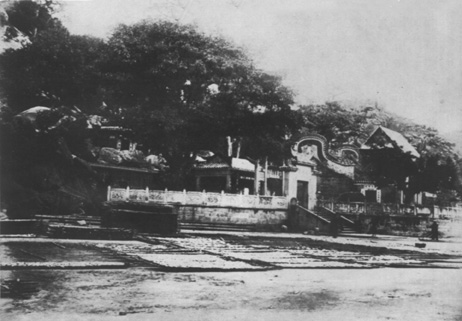 Ah-Ma Temple towards the end of the 19th century (photo published in 'Jornal Único'. Macau, 1898).
Ah-Ma Temple towards the end of the 19th century (photo published in 'Jornal Único'. Macau, 1898).
D. ANTONIO JOAQUIM DE MEDEIROS
The Count of Arnoso reports that: 'The current Bishop of Macau, D. António de Medeiros, is very keen on these two schools (St. Joseph's Seminary and the Canossian Welfare House). We met him while still young, thin and pale, withered by the fevers of Timor, caught when he recently toured the island checking the missions that he had established. We were interested, too, in his views about the current and future conditions in Timor'.
Bishop Medeiros died in 1897. His early death was caused by his work and tiring tours throughout the missions that he established in Timor. There he opened schools for boys. What about the girls? In Timor, nobody had ever thought about girls' education. However, Bishop Medeiros took the Canossian Sisters to Timor and they have been playing an important role in girls' education, providing them with a sound moral education.
Medeiros also brought the Jesuits back to Macau after being expelled in 1871.
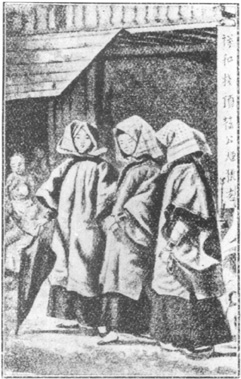 Christian Chinese ladies going to the mass. (In 'Tai-Ssi-Yang-Kuo', 'Arquivos e Anais do Extremo Oriente Português', Series II, Vol. IV (1889-1900).
Christian Chinese ladies going to the mass. (In 'Tai-Ssi-Yang-Kuo', 'Arquivos e Anais do Extremo Oriente Português', Series II, Vol. IV (1889-1900).
POLICE
According to the Count of Arnoso: 'The Macau Police is formed of the Police Guard which accommodates its companies in St. Agostinho, Mouros, Flora and St. Domingos barracks. As there are not enough European soldiers, they resort to the Chinese to fill the vacancies. The locals wear shoes and Chinese gaiters, large blue shorts and jackets, made of similar material. They wear Chinese straw hats with the royal coat of arms painted on the front and the words Guarda Policial de Macau.'
The police in Macau are as old as the city itself, but the first royal authorization which specifies the regulations of captains in charge of the rounds dates from the 14th of March 1691.
In 1719, upon orders issued by the Governor, the Senate established three Safe Houses in three districts - Sé, St. Lourenço and St. António.
In 1784, the police were replaced by a battalion of 150 soldiers of Goa's regular army. Besides protecting the city, the battalion had to police it.
The Prince Regent Battalion, which policed the city, was established on the 13th of May 1810. However, this battalion was dismantled in 1822 and the Safe Houses were reinstated with twenty men each. A Police Corporation was established on the 3rd of May 1841, following a royal decision which approved the police regulations for Macau city and harbour.
The Bazar Police were established on the 29th of September 1857 and the Macau Police Corporation on the 11th of October 1861, but the latter operated both onshore and offshore. In 1868 the offshore section was styled 'Macau Police' Corps and became independent from the onshore section and was headed by the Harbour Captain. The regulation of the Macau Police Corporation was published in no.32 of volume XV of the Government Gazette, dated the 9th of August 1862.
The Police Corporation was disbanded on the 18th of January 1879 and was replaced by the Macau Police Guard.
Both the Artillery Subdivision and the Police Guard were disbanded on the 16th of August 1895, and two army subdivisions were then established.The regulation of the Police Services of the Macau Municipality was published on the 8th of April 1920, but it was replaced in 1937 by the regulation of the Macau Public Security Police, which became an independent institution.
Pursuant to Decree no.21-81-M, dated 1881, the regulation of the Macau Public Security Police was enforced and it is still in effect.
THE MILITARY
The Count of Arnoso notes that: 'There is also the National Battalion which has a subdivision on duty in the middle of the Chinese part of the city. We witnessed one of its training exercises and we were very impressed with their appearance and precision of movements. The security system in Macau is not that good. The current governor and our friend Firmino José da Costa is trying to change it and has ordered the 'Primeiro de Dezembro' battery to be changed into a gun platform.'
The National Battalion, which was originally styled 'Provisional Battalion', was established by Governor João Maria Ferreira do Amaral, upon a royal decree dated 10th December 1847. Initially, it used the former St. Domingos Convent, in the middle of the city.
As regards the 'Primeiro de Dezembro' battery, the Public Works Director, Eng. Francisco Jerónimo Luna wrote the following on the 22nd of May 1873: "This new battery is built on the far end of St. Francisco beach; its construction started on the 1st of December 1872 and is made of a thick and hard wall covered with masonry which is able to withstand the reclamation. The total reclamation area is 1374 square meters.'
Governor Firmino da Costa built on this reclamation a trapezoid shaped structure. This battery which housed both the garrison and the ammunition was demolished in 1934.
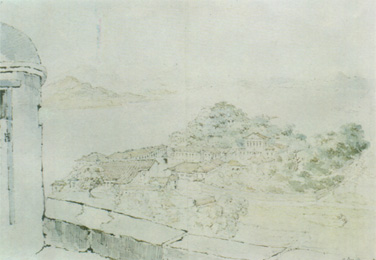 Camões Garden with the Garden House seen from the Monte Fortress (1850)-Dr. Thomas Watson (1815-1860). Pencil, brown paint and water-colours, 20 x 28 cm, Luís de Camões Museum Collection).
Camões Garden with the Garden House seen from the Monte Fortress (1850)-Dr. Thomas Watson (1815-1860). Pencil, brown paint and water-colours, 20 x 28 cm, Luís de Camões Museum Collection).
FLORA GARDEN
'The small Flora Palace, which is also the Governor's house, is very beautiful. There, next to a Le Notre style garden, we can see a nursery from where the trees existing currently on the Macau hills were taken', wrote the Count of Arnoso.
The Flora Garden was owned by Father Vitorino José de Sousa e Almeida. In 1848 he built there a palace designed by José Tomás de Aquino, a Macanese architect. This palace was later sold to the government in 1872-1873 to serve as a summer house of government officials. However, as that place was unhealthy it was later abandoned.
The garden was bought by the Government Finance Department and later by Sir Robert Ho Tung, but the government took back the place subsequently. The palace became a kindergarten in 1924.
Governor Tomás de Sousa Rosa planted there many trees as referred to in the work 'No Oriente, de Nápoles à China' (in English: In the East, from Naples to China) by Adolfo Loureiro.
The Guia Hill was forested but it is now being spoiled due to the construction of high-rise apartment buildings.
VITÓRIA MONUMENT
According to Arnoso: 'Nearby Flora, in the middle of one of the Police's military parades and where supposedly Admiral Roggers died, there is a simple granite monument protected by iron bars. On top of the monument, the Portuguese royal coat of arms is displayed overlapping a cross around which the following can be read: Of the city of the Holy Name of God. On one side of the monument one can read an engraving saying: This is to perpetuate the victory of the Macau Portuguese over eight hundred armed Dutchmen who disembarked at Cacilhas Beach under the leadership of Admiral Roggers on 24th June 1622. The victory was achieved thanks to the intervention of St. John Baptist, who later became their patron saint.
On another side the following is engraved: Leal Senado built this monument in 1864 in the very same place of a stone cross which perpetuated the glorious undertaking by the Portuguese'.
It should be noted that Admiral Roggers did not die there, as during the fighting only seven Dutch captains were killed, none of them being an admiral.
The Vitória monument was not built in 1864, but on the 26th of March 1871 instead, by Governor Admiral Antonio Sérgio de Sousa.
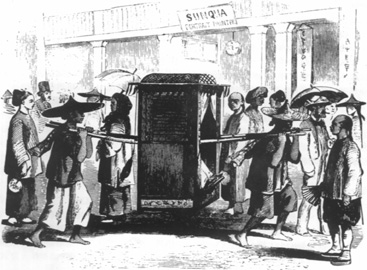
Coolies carrying a litter.
(In 'The Hong Kong Illustrated - Views and News, 1840-1890').
Leal Senado's attorney had the idea of the monument and he presented it at a meeting held on the 25th of June 1862. Upon approval of his plan he assigned Carlos José Caldeira to order the monument from Portugal. It finally reached Macau in June 1870 and was inaugurated the following year. That place was commonly known as the "Repentants' Ground".
THE GUIA
Arnoso reports that: 'From the Guia lighthouse, the first ever built in the China Sea, one has a nice view of the the bay, Taipa, Lapa and St. John Islands, the city climbing up to Penha de França; the Inner Harbour and the Green Island, the narrow strip of land and the distant mountains of China.'
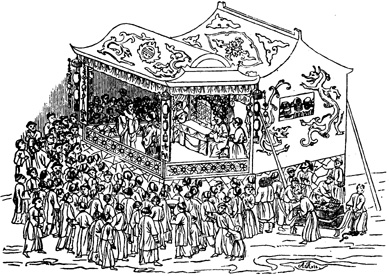
Outdoor Chinese Theatre.
(In The Hong Kong Illustrated).
1687-1720
Governor José Rodrigues Coelho do Amaral had the initiative to built the Guia lighthouse and the Macanese Carlos Vicente da Rocha designed its mechanism. It was inaugurated on the 24th of September 1865 and during the typhoon of 1874 its tower was badly damaged, which forced its reconstruction.
On the 29th of June 1910 it was replaced by a lighthouse made in France.
Arnoso also writes about an interesting statue which he found in the churchyard: 'In the churchyard on a pedestal-like stone lies a rough and disfigured statue which is believed to have been built in honour of a brave captain. He is wearing a corselet, large shorts and boots up to his knees. A painter added the moustache and goatee beard. He also painted his corselet in vivid pink and drew yellow colonel gallons on his lapel. Poor hero!'
As regards this statue, it is believed to be that of a Dutch officer moulded by the Dutchmen arrested at the Guia fortress, following their defeat on the 24th of June 1622. The statue was moved from the Guia Hill to St. Paul's Ruins and in 1966 it disappeared. Later, Alfredo de Almeida found it beheaded, in a gutter. He then put the head back on the bust and took the statue to his Flora Garden. Presently, it is displayed in the Luís de Camões Museum in a very secondary place. The colours of its corselet have faded and it has no pedestal anymore. Wounded on the neck, thanks to its beheading, it lies on the floor without an inscription. In fact, it should return to the Guia Hill where it had been for four centuries.
CAMÕES GROTTO
Arnoso describes the Camões Grotto in the following manner: 'The grotto, formed of three granite rocks shaped like a dolman, lies on top of a hill and in a garden, or small wood, in view of the number of its old trees (...).
Fortunately, the government owns that place, which is visited by all tourists coming to Macau. At the time, the governor of Macau was our friend, Thomaz Rosa. He learned that a French priest was planning to buy the grotto and immediately sent a cable to the Marine Minister, seeking authorization for the purchase of one of the most glorious monuments of our history. The Marine Minister was Manuel Pinheiro Chagas who took no time in cabling back his approval. The garden's narrow streets are paved with cement and in a small square there is an elegant bamboo bandstand. There are nice Ficus Indica trees with old roots embracing the rocks as if they were strong settings for precious stones. On the thin bamboo canes, yellow and green spotted, names of beloved women are engraved. The sparkling sun is unable to pass through the dense trees; birds sing happily, flying from branch to branch and huge coloured butterflies fly from petal to petal. Next to the grotto and climbing up to the highest spot in the garden, there is a sort of stone and lime watchtower with an opening towards the meridian. It is said that La Pérouse tuned his instruments in this improvised observatory.'
FERREIRA DO AMARAL
According to Arnoso: 'All Portuguese visiting Macau must pay a visit to the Amaral Stone in honour of this brave and courageous governor, who was treacherously murdered by the Chinese. The rock where the corpse of the murdered governor was found on the 22nd of August 1849, is located in the Porta do Cerco road near Mong-Ha Fortress. The Portuguese coat of arms engraved on the rock is the only thing that perpetuates his memory. However, the Macau peninsula owes its full independence to his courage. He forced the Chinese to retreat beyond the customs on the strait and was warned not to go for his regular walk because he could be killed. The warning notwithstanding, he decided to go ahead and met a poor old lady to whom he used to give alms. Again she warned him of the death threat. But he would never turn his back on any danger and went on until he was murdered. As soon as this news was heard, the Government Council convened and decided that the Chinese should be expelled from the border (Porta do Cerco). As a huge force gathered at the Passa Leão Fortress which overlooks the strait from the Chinese side, the city feared the worst, as it was expected that those people would come back for revenge. Then, Colonel Mesquita who ended as tragically, offered to attack the Chinese fortress. He headed a group of courageous men and managed to take over the fortress, where he hoisted the Portuguese flag. The Chinese mandarin who had remained in Macau since the Portuguese first settled here, as a means of protest against the Portuguese domain, got scared and tied the peninsula for good.'
It should be noted that the mandarin came to Macau in 1744, two centuries after the Portuguese settled here.
CHINESE HOUSES AND SHOPS
Arnoso reports that: 'The type of house is always the same, with ground and first floors. The ground floor is used as a shop and the first floor for home. From the first floor one can see what is happening on the ground floor, as there is an opening on the floor like an open skylight. The counter goes from the entrance to the back of the shop. It ends always towards the street in an elegant wooden triangle - shaped piece lying on the counter. Some of those red or golden ornaments, or in wooden colours, very well carved, are true works of art. Usually, vertical signboards are narrow and long with their engraved characters painted in gold or black on a red bottom or vice-versa. Shoemakers have the nicest shops and the richest signboards. Almost every shop has blue canopies. Sitting on the inner side of the counter, the Chinese write on half-pieces of paper. Next to them there is always an abacus. It should be mentioned that the use of the abacus in China dates back to the reign of Emperor FouHi, in the year 2852 BC. It is amazing how all Chinese use this instrument so well and some can even make two operations at the same time using two abacuses. Slaughter houses display pieces of beef and plucked poultry. Under the canopies and on the streets and next to banks they prepare tea and cook on burners as they do at popular reunions in Portugal. Hucksters announce fruits, the reddish lychees that taste like muscatel grapes, while others announce vegetables. Thousands of Chinese crowd the streets.'
PAGODAS
According to Arnoso: 'The main pagodas in Macau are the Barra Pagoda, the Porta do Cerco Pagoda and the Matapan Pagoda. The major religion is Buddhism even though it was initially considered to be against the law. It has a great number of gods. It has a heaven, a purgatory and a hell. The final destination depends on the gifts given to the gods and the level of virtues displayed on earth. As they believe in metamorphosis, some commit suicide in order to be reborn as mandarins (...)
The most virtuous ones go straight to heaven, where they enjoy eternal bliss; those who are not so virtuous return to earth as mandarins; and the sinners go straight to hell. The priests fast, are single and shave their heads with knives. All pagodas look very much the same.'
As regards the Matapan Pagoda, we do not know to which he is referring as we do not know any with that name.
According to the founder, Sakyamuni, Buddhism has only "four sacred truths:"
1. Everything is pain;
2. The pain comes from the urge of living and enjoying;
3. It can only be suppressed by killing desire and this leads to the peace of Nirvana;
4. The route leading to it has eight crossroads, as follows:
(a) morality (5 rules of life; truthfulness, sweetness, decency, peace, harmony);
(b) concentration (self control, lucidity, serenity, moderate joy);
(c) wisdom which admires the void of the world, suppresses desire and ends in Nirvana.
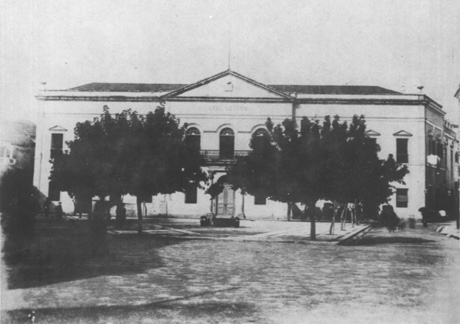
Leal Senado facade towards the end of the 19th century.
(photo published in 'Jornal Único'. Macau, 1898).
THE PORTA DO CERCO PAGODA
This is the Lin-fong-miu or Lotus Pagoda and Arnoso describes it as follows: 'The Porta do Cerco Pagoda overlooks a large rectangular site surrounded by a brick wall with four old and large trees. A stairway composed of six steps and two stone dragons on the sides leads to the three pagoda doors. The central building is taller than the lateral ones. Black and white tiles lay on the smooth roof timberwork. The walls feature drawings of fantastic monsters. Doors are fitted with wooden windscreens between wooden pillars like the ones inside the temple. Vows and sentences are written on long, narrow red boards. On altars with skilfully carved wooden antependium featuring a red bottom and golden relief, red pieces of paper, tallow-candles and red and brown incense burn in bronze vases, opposite idols surrounded by tall paper flower pyramids. Larger and more extravagant idols surround altars. Others rest on chairs near the doors, in wall niches, with their disfigured hands crossed over their huge bellies. The temple features idols with different expressions, from the happiest face to the most serious one. A big drum hangs from a rope in the middle of the pagoda. In one section of the temple there is a pond with slimy water where nice lotus plants grow. The wooden roof over the pond has an opening towards the sky like a small cloister. On altars there are small wooden sticks which are tossed into the air in groups of three in order to learn about one's fortune. The fortune depends upon the position in which the sticks fall.'
RESPECT FOR THE DEAD
Arnoso says that: 'The Chinese have great respect for the dead; they bury them with great pomp, using large wooden coffins. They have no cemeteries and bury their dead on the hills in a place preciously chosen by a priest. This choice can take many days and the body has to wait in the house until the priest finally arrives at a conclusion.'
This choice is related to fong-soi. A good place, featuring good conditions for the soul's rest must be found.
Luiz Gonzaga Gomes in his Macau, Factos e Lendas states that 'Everybody knows that the Chinese care a lot for fong-soi (wind and rain) i.e. geomancy. To this superstitious people, the positive and negative influences of life are related to the direction of water flow, the position of a mountain, the specific position of a grave and many other things that one has to face every day.'
Geomants considered Macau as the ideal place for good fong-soi: the Praia Grande was a huge and promising crab whose eyes were the former St. Peter and St. John fortresses, the former being currently the location of Jorge Álvares' statue and the latter was opposite 'Travessa de S. João.'
That is why they painted houses in green or yellow, the colours of crabs.
The dragon is another auspicious animal and Macau had a gigantic dragon: its head was the Penha Hill and the body extended as far as Lapa Island across the delta; it crossed the river to reach Chin-San, with its tail ending at Portas do Cerco. 'Avenida Almeida Ribeiro' was the sword, which cut the dragon in two, the south and north of Macau.
CEMETERIES
Arnoso says that: 'There are three cemeteries in Macau: the Catholic, the British and the Parsee. In Parsee cemeteries all graves are exactly the same, there is no difference between rich and poor people. These are the real grounds of equality.'
He refers to St. Michael, Protestant and Parsee Cemeteries. St. Michael Cemetery was built in 1853-1854 following a public collection of funds and was inaugurated on the 2nd of November 1854. The Diocese took it over in 1856 and therefore it became the Catholic Cemetery.
The Protestant Cemetery at the Camões Square, was built in 1821 for all Protestant people rather than for the British only. This was the old cemetery, as there was another one at Mong Ha which was sold to the government in 1971 for the nominal amount of one pataca.
The Parsee Cemetery at the Guia area was built in 1829. The Parsees were descendants of the Persians who emigrated to India in the 8th century following the Arabian invasion. Around 1771 the Bombay Parsees began trading with the Chinese. Of the fourteen people buried there, eleven are from Bombay and the oldest grave displays the following inscription: 'In memory of Cursetjee Franjee, born in Bombay, who died on 17th March 1829, at the age of 56'.
KENG-WU HOSPITAL
Arnoso gives the following description of this hospital: 'The Chinese hospital is heavily sponsored by the wealthy Chinese and looks very much like a pagoda. Chinese tycoons meet there around a large table and sit on heavy armchairs to decide on any business in which they might be interested. All governors visit this hospital after their swearing-in ceremony; they are welcomed by the Chinese community leaders. On the walls there are sentences engraved on marble and in front of a Buddha a lamp is burning. A garden divides this area from the hospital itself. Rooms are located on both sides of long corridors and each room, relatively clean, has a bed with a cotton curtain. The poor Chinese enjoy a lot of benefits from this hospital. Even Catholic Chinese do not like to be treated by Europeans. They never lose their religious principles. Rumour has it that a Catholic Chinese preferred the death of his wife during childbirth rather than let her be treated by a European doctor.'
The Chinese Keng-Wu Hospital was founded in 1871 and the authorization for the operation of the hospital was granted on the 26th of June 1870.
In 1888, Ching-San's Maritime Security Department granted the hospital a piece of land on the other side of the border for a cemetery.
Sun Yet Sen, the founder of the Chinese Republic, upon completion of his graduation in medical studies at Hong Kong's Medical College, joined this hospital in 1892 and he was the first to practice European medicine there.
OPIUM HOUSES
Arnoso calls them clubs and gives us the following description: 'It is not a very big house and has many small compartments with beds where they smoke opium, like single cots on the walls. Wainscots are made of fine and delicately engraved wooden screens. These houses have screens like these and are used as partitions. Each compartment is large enough for two persons smoking at the same time. In the middle of the bed and on a tray one can find the pipes, alcohol lamp, a small box with opium and the metal stiletto used to fill pipes with opium. Against the back wall there are two Chinese wooden pillows, as hard as stone. Pipes look like long flutes with the opium container attached to one of the extremities. The container is round and large with a small hole. The club's furniture is expensive as it is made of tamarind, with marble incrustations.'
Next, he describes a Chinese man, Lam-Hami-Lin, smoking opium: 'Lying on one side on the bed, with his head resting on the hard pillow, he started by opening the little opium box with much care; he then lit the lamp and with the stiletto he put a bit of jelly opium in the fire. While burning, he spun the rod to prevent it from dropping. A few minutes later, after the opium had became a fragrant ball, he inserted it through the container hole while putting the pipe bowl in the fire. Always lying down, he passionately inhaled the fragrance, with his eyes half closed.'
THE FANTAN GAME
Arnoso says that: 'The Chinese have a passion for gambling like no other people. In the Chinese district of Macau there are a lot of fantan houses. Featuring balloons and lanterns they operate throughout the day until midnight. The gambling room is on the first floor. After climbing the stairs on the back wall and opposite the landing there is a Chinese inscription saying "Find happiness on the first floor". The game is played on a square table covered with a thin mat. The banker sits at one of the sides and places the stakes according to the points and pays them afterwards. He has the help of a Chinese who is sitting next to him in front of a small stall. This man has a scale with him, and prepares the change in paper rolls, after which he writes the amount on the outside. The scale is absolutely necessary, because the Chinese like to stamp coins and that makes them lose weight. To the left of the banker a Chinese prepares the play. A wooden square in the middle of the table marks all bets. One can choose 1, 2, 3 or 4 of any combination of these numbers. Those betting only on one number win three times the amount of the bet, those betting on two numbers win two times and those betting on three numbers win one time. These winnings are subject to a 7% commission to the banker. The Chinese who prepares the play has around two hundred Chinese coins and a china or metal bowl. From this bunch of coins he removes a few and covers them with the bowl. Once all bets have been placed, he removes the bowl and with a wooden stiletto he separates the coins one by one in groups of four. The winning number corresponds to the number of coins left in the last move. So, if four coins are left in the last move number 4 wins, and so forth. The division of coins and subsequent payments make it a slow game.'
Currently, many other games are played in the Macau casinos.
RICH FAMILIES
Arnoso says that: 'There were very rich families in Macau; however, the ban on the emigration of coolies and the 1874 typhoon followed by flooding, fires and looting made that wealth disappear. Only the wealth of the few who had their money in powerful insurance companies or in Hong Kong properties managed to escape from that catastrophe. It is said that before that, ladies used to take their servants with them to parties so that they could change clothes three times in one evening. Some houses had golden cubes preventing doors from banging against skirting boards. At the theatre, not only flowers were thrown onto the stage, people used to throw pearl necklaces, sapphire and ruby ornaments. They earned a lot of money almost without working; they spent a lot of money and nobody thought about tomorrow. Both rich and average people had idle lives!'
This is quite exaggerated. Arnoso reports what a boasting Macanese told him. I published the book 'O Teatro D Pedro V' and I have not come across any report of ladies throwing pearls and necklaces onto the stage.
Macau became decadent with the foundation of Hong Kong. The only exception was the emigration of coolies, when only very few families managed to get rich.
Translated by José Vieira
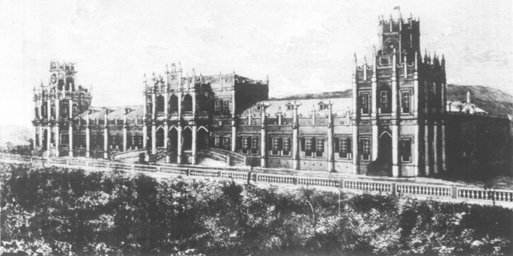
Count of S. Januário Hospital. View of the Hospital's spectacular facade, designed by the Baron of Cercal, António Alexandrino de Mello; Cap. Henrique Dias de Carvalho (Director of the Public Works Department) directed the construction works. It was inaugurated on 1st December 1872.
* Bernardo Pinheiro de Mello (1855-1911), 1st Count of Arnoso, was a nobleman, secretary to King Carlos I and his friend. He was the Viscount of Pindela's son, and he was referred to as Bernardo Pindela in the literary assemblies that he took part in. For instance, Eça de Queirós, to whom he was friend, and the renowned group called 'Vencidos da Vida' (in English: Life Losers). He was an Engineering Officer and a famous writer at the time (Azulejos with preface written by Eça de Queirós; De Braço Dado -short stories in conjunction with the Count of Sabugosa: Primeira Nuvem e Suave Milagre - plays). He took part in the King Carlos I entourage on his trips to Spain, France, Germany and England. On a diplomatic mission, he went to Peking with Tomas de Sousa Rosa. This trip originated his book entitled Jornadas pelo Mundo (in English; Trips Around the World-1894.
start p. 60
end p.